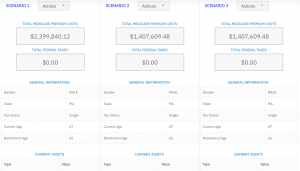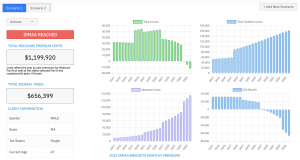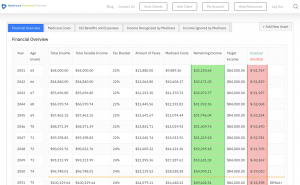It was a crisp, autumn morning when my neighbor, Joe, got his mail. He held an envelope, his expression one of confusion. “What’s this Medicare IRMAA thing?” he called out across the fence.
You see, like many folks hitting retirement age and navigating the Medicare maze for the first time, Joe had just been hit by something unexpected – a higher premium because of IRMAA (Income-Related Monthly Adjustment Amount).
If you’re in Joe’s shoes or simply want to be prepared for future healthcare expenses as part of your financial planning strategy, then stick around. We’ll unravel what Medicare IRMAA is all about and how it can impact you based on various life-changing events or changes in income brackets.
to unpredictable economic changes. By the conclusion of this guide, you’ll possess a range of approaches to confront increasing expenses directly.
Understanding Medicare IRMAA
The Income Related Monthly Adjustment Amounts (IRMAA) is a surcharge that affects certain Medicare Part B and/or Part D recipients. This extra cost is for individuals whose income goes beyond a specific threshold. So, what does this mean in simple terms? Think of it as an ‘extra fee’ you need to pay on top of your regular Medicare premiums if you’re earning more than the average Joe.
Defining Medicare IRMAA
Let’s try to comprehend precisely what this term signifies. The definition of Medicare IRMAA revolves around how it impacts your healthcare costs based on your earnings. Basically, the higher your income, the more likely you are to see a hike in premiums due to IRMAA.
This isn’t some arbitrary charge conjured out of thin air either; there’s method behind it all. In fact, Social Security determines who pays these additional fees using information from IRS tax returns submitted two years prior.
The Impact of Medicare IRMAA
If Social Security finds that someone has crossed over into higher income brackets according to their adjusted gross income reported earlier – voila. They end up having an “income-related monthly adjustment”. Essentially they’re paying more for their healthcare services through increased premiums under both parts B and D.
In layman’s terms: If Uncle Sam sees that you’ve been raking in big bucks recently – brace yourself because those hard-earned dollars might also mean coughing up extra cash towards medical care coverage.
Note:Paying attention here can help avoid unexpected charges when planning retirement benefits. Being prepared for these additional costs is a crucial part of successful Medicare planning.
The Calculation Process for Medicare IRMAA
Understanding the calculation process for Medicare IRMAA, or Income-Related Monthly Adjustment Amount, is crucial if you want to get a grip on your healthcare costs. It’s all about how your income influences your premiums.
How Your Income Influences Your Premiums
Your adjusted gross income (AGI) and tax-exempt interest income from two years prior play significant roles in this equation. These figures are sourced from your IRS tax return. This data forms the foundation of what we call ‘modified adjusted gross’ which then determines where you fall within specific income brackets.
In essence, higher incomes lead to higher premiums because Social Security Administration (SSA) uses these numbers as an indicator of one’s ability to pay more towards their own care – hence leading to a premium increase through the IRMAA surcharge.
To illustrate: If Mrs Smith had a high-income year due to receiving an employer settlement payment in 2023, her AGI will be increased accordingly when she files her 2023 taxes in 2023. Consequently, SSA would base its determination of Mrs Smith’s monthly adjustment amount for Medicare coverage on this inflated figure – that could potentially lead into paying IRMAA charges in 2023.
If however she experienced life-changing events such as marriage divorce afterwards affecting her financial status negatively or even positively it needs reporting immediately so SSA can adjust payments accordingly without having any delays whatsoever.
Note: Life-changing events can impact both social security benefits and Medicare enrollees’ premium levels. Always keep track and report promptly.
A Glimpse into the Future
Anticipating ahead, the amount of your yearly wages will be a deciding factor in whether you are liable to IRMAA. By understanding this process and staying proactive with tax planning strategies, you can potentially reduce or even eliminate these additional costs.
Remember, planning early is key. It’s important to fully grasp how Medicare operates in tandem with other aspects.
Key Takeaway:
Understanding Medicare IRMAA: It’s vital to know how your income impacts your premiums. Your adjusted gross income and tax-exempt interest from two years ago shape this. Higher incomes lead to higher premiums, but life events can affect these too. Planning ahead with proactive tax strategies may help you reduce or even dodge extra costs.
Life-Changing Events Impacting Your Medicare IRMAA
If you’re navigating the world of Medicare, you might already be familiar with Income Related Monthly Adjustment Amounts (IRMAA). But did you know that life-changing events can affect your IRMAA status? Let’s dive into this important topic.
Significant Life Changes and Their Effects
Certain major life events can cause a significant shift in your income level. For example, marriage or divorce could change your tax filing status and subsequently alter the adjusted gross income reported on your IRS tax return. The same goes for an employer settlement payment – it’s another form of increased income that Social Security takes into account when determining who pays IRMAA.
This is where things get interesting because these shifts can lead to changes in what we call ‘Medicare premium adjustments’. These are essentially surcharges based on higher incomes which are added to standard premiums paid by Medicare enrollees. Additional payments are requested of those with larger incomes to help cover their healthcare expenses.
The Reporting Process: It’s All About Timing
The key thing here is timing; promptly reporting these changes to the Social Security Administration (SSA) is crucial because they use this information from two years prior to determine if someone should pay an additional amount due to having a higher income than typical beneficiaries. If there has been a significant drop in annual income following any of these life-changing events, SSA needs this data ASAP so they can reassess whether or not one should still pay IRMAA. Learn how here.
To give them updated figures after such an event, consider amending your past federal tax returns using Form 1040X via the IRS. It’s a bit of work, but it could mean significant savings on your Medicare premiums.
It’s clear that these life-changing events can significantly impact your Medicare IRMAA status. Being proactive and informed will help you navigate this complex process more effectively.
Key Takeaway:
Major life events like marriage, divorce, or receiving an employer settlement can impact your Medicare IRMAA status by changing your income level. To ensure accurate premium adjustments, report these changes promptly to the Social Security Administration. Updating past tax returns could also help save on premiums. Staying proactive and informed is key in navigating this complex process effectively.
How Social Security Benefits Interact with Your Medicare IRMAA
If you’re a beneficiary of both Social Security retirement benefits and Medicare, you may wonder how these two programs interact. Specifically, how does your Social Security income impact your Income-Related Monthly Adjustment Amounts (IRMAA)? Let’s explore this.
Balancing Benefits with Costs – How your social security benefits can affect your Medicare IRMAA
The amount of money that comes to you via Social Security isn’t just for spending freely. Part of it might go towards healthcare costs through the IRMAA surcharge on certain higher-income individuals enrolled in Medicare Parts B and D.
Your modified adjusted gross income (MAGI), including any taxable part of your Social Security funds, is a major factor in this. The Social Security Administration (SSA) uses MAGI data from IRS tax returns filed two years prior to determine if someone needs to pay an additional monthly premium due to high income levels.
In other words, if you receive substantial retirement benefits from SSA or another source pushing up annual earnings above the threshold defined by SSA (income brackets found here) then expect a bump in what’s called the “Part B Premium”. This also applies for those opting into prescription drug coverage under Part D – adding another layer to overall expenses.
The bottom line is clear: greater retirement cash flow could mean paying more for your Medicare coverage due to IRMAA. It’s a tricky equilibrium between what you obtain and the expenses you incur.
The Impact of Medicare IRMAA on Prescription Drug Coverage
When you think about your Medicare Part D premiums, do the words ‘IRMAA surcharge’ pop up? If not, they should. For those with higher incomes, an extra charge known as Income-Related Monthly Adjustment Amount (IRMAA) applies.
Balancing Medication Costs
You see, Medicare’s prescription drug coverage, or Part D plan costs can be impacted by this pesky little thing called IRMAA. It’s a surcharge that folks with income above certain thresholds have to pay in addition to their regular premiums.
Why does it matter?
This additional amount could lead to higher out-of-pocket expenses for medication and overall healthcare services if not planned correctly. However, we have some strategies that can help you manage these costs and avoid surprises.
Managing Costs and Avoiding Surprises
To avoid unexpected increases in your premium payments due to the IRMAA determination process, it’s important to stay informed about how your annual income affects these charges.
The Social Security Administration uses tax returns from two years prior when determining who pays what – so keep an eye on those numbers. Remember: if there are significant changes in income because of life-changing events like marriage or divorce – SSA needs to know ASAP.
Paying Your Medicare IRMAA Premiums
When it comes to paying your Medicare premiums, especially those affected by Income-Related Monthly Adjustment Amount (IRMAA), timing and accuracy are critical. These adjusted premiums can feel like a puzzle, but with the right approach, you can solve it efficiently.
Navigating Payment Options for IRMAA
The payment options available for Medicare IRMAA are designed to give beneficiaries flexibility. Whether you’re comfortable with traditional mail or prefer digital methods, there’s an option that suits your preference. But remember – regardless of how you pay, punctuality is crucial.
If late payments become a habit, consequences may follow. While these won’t include anything as drastic as jail time or losing coverage entirely; they could mean higher future premiums or even being billed directly by Medicare if deductions from Social Security benefits aren’t sufficient due to unpaid bills.
Managing Costs Effectively
You might wonder: “What happens when I have difficulty managing my costs?” Well, in such cases help exists. You may qualify for assistance programs that aid in covering premium costs and prescription drug coverage expenses. Every penny saved counts.
An important aspect of effective cost management involves understanding your income level and its impact on potential surcharges based on annual income thresholds defined by SSA.
This means staying informed about changes related to gross income reported on IRS tax returns which determine whether one pays the additional monthly adjustment known as the IRMAA surcharge.
Remember, staying informed and timely payments are your best allies in navigating the Medicare IRMAA landscape. So get on top of it today.
Navigating Changes in Marital Status and Their Impact on Your Medicare IRMAA
When it comes to your Medicare IRMAA, changes in marital status can cause significant shifts. Marriage or divorce can lead to drastic variations in income, affecting the monthly adjustments for premiums.
Your adjusted gross income (AGI) plus tax-exempt interest – what Social Security calls your modified adjusted gross income (MAGI) – determines whether you’ll pay an Income-Related Monthly Adjustment Amount (IRMAA). If marriage pushes that combined total above certain thresholds, you could be facing a higher premium.
Fortunately, there is an option to appeal the decision. Significant life-changing events like these allow you to request a new initial determination from Social Security. You just need to report the event and provide proof of estimate for your current year MAGI. This way, they don’t keep using old data based on years prior when setting up your payments.
The Role of Tax Returns In Determining Your Medicare IRMAA
Social Security uses IRS tax return information from two years ago when deciding who pays an extra amount for their Medicare Part B and prescription drug coverage premiums. So if getting hitched boosted or reduced that figure beyond one of those crucial income brackets, notify them about this change.
Taking Control: Reporting Changes In Income Due To Marriage Or Divorce
If wedded bliss – or its dissolution – has led to a significant income change, it’s crucial that you inform the Social Security Administration. A marriage or divorce can lead to changes in your monthly surcharge based on reported income. It’s important not just for this year but also because SSA determines who pays IRMAA using information from two years prior.
So if you’ve recently said “I do” – or decided ‘you don’t’ anymore – be sure to report these life-changing events promptly and ensure your Medicare premiums reflect your current reality.
Key Takeaway:
Shifts in marital status, like tying the knot or getting a divorce, can swing your Medicare IRMAA. That’s because these events might change your income and impact monthly premiums. But don’t fret – you can ask Social Security for a new determination based on your current income. Also, it’s important to keep them updated about any major changes. This way, they’ll always have accurate information and there won’t be any unexpected surprises.
Understanding the Medicare IRMAA Determination Notice and Appeals Process
The Medicare Income-Related Monthly Adjustment Amount (IRMAA) determination notice is a document that can stir up many questions. This essential piece of mail provides key details about your premium adjustment, so it’s crucial to understand its contents.
Reading Your Determination Notice
Your first encounter with the Initial IRMAA Determination Notice may seem daunting. Don’t be intimidated by the technical language; this guide will help you make sense of it.
You’ll find information about your new premium amount on this notice. It also mentions why Social Security believes you should pay more for your Part B and/or Part D premiums due to higher income reported two years prior.
The key thing is not to discard this letter – keep it safe. You never know when you might need these details again if ever there’s a question about receiving notice of Medicare IRMAA determination or appealing decisions regarding surcharges.
Navigating the Appeals Process
If life has thrown unexpected twists at you in recent times – like marriage, divorce, retirement benefits changes or other life-changing events affecting your income – an appeal could be necessary because these changes might influence how much extra ‘premium’ we’re talking about here.
To start an appeal process, make sure that all relevant documentation supporting these changes are available as proof. From tax returns showing reduced adjusted gross income after job loss or death of spouse receipts indicating employer settlement payments upon retiring early— every bit helps.
Preparing for Medicare IRMAA
Getting ready for the Income-Related Monthly Adjustment Amount (IRMAA) means understanding your income level and its potential impact on your Medicare premiums. It’s about taking a deep dive into those tax returns from two years prior, as they play a key role in how Social Security Administration determines who pays IRMAA.
Your Tax Return: A Crystal Ball Into Your Future Premiums?
Your IRS tax return serves as an indicator of what you might expect to pay in terms of premium increase due to IRMAA. Think of it like looking into a crystal ball that predicts future expenses based on past income.
The greater your adjusted gross earnings, the more probable it is that you will be categorized in one of the higher-income categories which could lead to a heightened month-to-month fee. So, staying aware can help prepare you for possible changes in costs related to Part B and/or Medicare prescription drug coverage.
Life-Changing Events Can Impact Your IRMAA Status
Sometimes life throws curveballs—marriage, divorce or retirement benefits can all significantly alter your annual income levels. Such life-changing events could influence whether or not you’re required to pay an additional surcharge based on updated information from amended income tax returns. SSA suggests reporting these significant changes promptly so they can adjust their calculations accordingly if needed.
Paying Your Adjusted Premiums: Plan Ahead.
Last but certainly not least is planning ahead when it comes time actually paying those pesky increased premiums. You want avoid any penalties associated with late payments by setting up automatic deductions directly from social security benefits if available – remember forewarned is forearmed.
IRMAA might seem like a complex maze, but with knowledge and preparation you can navigate it confidently.
Key Takeaway:
Bracing for Medicare IRMAA involves knowing your income level and its impact on premiums. Tax returns from two years ago are crucial, as they determine if you’ll pay an extra fee. Life events like marriage or retirement can affect your IRMAA status too. And don’t forget to plan ahead to avoid late payment penalties.
FAQs in Relation to Medicare Irmaa
What are the Medicare Irmaa thresholds for 2023?
The 2023 IRMAA thresholds aren’t out yet. Typically, Social Security announces them in late fall of the previous year.
What income counts for Medicare Irmaa?
Social Security uses your modified adjusted gross income (MAGI) to calculate your IRMAA. It includes wages, interest, capital gains and more.
How do I know if I have to pay Irmaa?
If you’re subject to IRMAA, you’ll get a notice from Social Security. They base it on your tax return from two years ago.
What is the Medicare threshold for 2023?
In 2023, single filers with MAGI over $91k and joint filers above $182k hit an additional premium cost through IRMAA.
Conclusion
Understanding Medicare IRMAA can feel like you’re lost in a maze. Navigating the Medicare IRMAA can be tricky, but with what we’ve discussed here today it’s simpler.
The process begins with understanding that higher income may mean higher premiums due to this adjustment. Life-changing events such as marriage or divorce can impact your IRMAA too.
It’s crucial to keep tabs on your tax returns and how they influence these costs. And let’s not forget the relationship between social security benefits and premium adjustments under this program.
In summary, mastering Medicare IRMAA is about staying informed, proactive planning and effectively managing changes in life circumstances or income brackets for optimal financial health during retirement years!
Table of Contents:
- Understanding Medicare IRMAA
- The Calculation Process for Medicare IRMAA
- Life-Changing Events Impacting Your Medicare IRMAA
- How Social Security Benefits Interact with Your Medicare IRMAA
- The Impact of Medicare IRMAA on Prescription Drug Coverage
- Paying Your Medicare IRMAA Premiums
- Navigating Changes in Marital Status and Their Impact on Your Medicare IRMAA
- Understanding the Medicare IRMAA Determination Notice and Appeals Process
- Preparing for Medicare IRMAA
- FAQs in Relation to Medicare Irmaa
- Conclusion
Streamlining the Medicare Surcharge Calculation Process.
Our Healthcare Retirement Planner software is designed to streamline the retirement planning process for financial professionals. By providing an efficient way to calculate IRMAA costs, our tool helps you save time and focus on other aspects of your clients’ retirement plans.
- Faster calculations: Our software quickly calculates IRMAA costs based on your client’s income and tax filing status, eliminating manual calculations and potential errors.
- User-friendly interface: The intuitive design of our platform makes it easy for financial professionals to input data and generate results with minimal effort.
- Data integration: Seamlessly integrate our calculator into your existing financial planning tools or CRM systems for a more streamlined workflow.
- Easy to Understand Reports: Export reports to easily share with your clients
- Tax and Surcharge Modeling: see how different types of income affects both taxes and your surcharges.
In addition to simplifying the calculation process, using our Healthcare Retirement Planner can also help improve communication between you and your clients. With clear visuals that illustrate how IRMAA costs impact their overall retirement plan, you can effectively convey complex information in an easily digestible format. This enables clients to make informed decisions about their healthcare expenses during retirement while ensuring they are prepared for any potential changes in Medicare premiums due to income fluctuations. To learn more about how our software can benefit both you as a financial professional and your clients’ retirement planning experience, visit the features page. Streamlining retirement planning processes can help financial professionals save time and resources, allowing them to focus on other areas of their clients’ needs. Automated calculation of IRMAA costs is the next step in streamlining this process even further.





